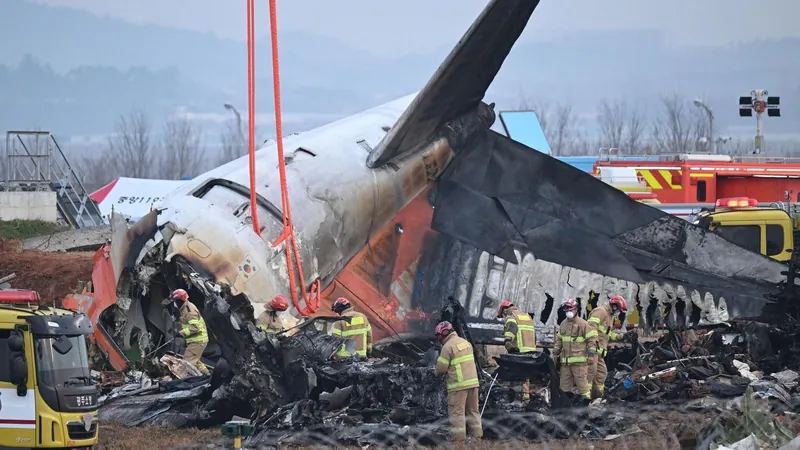
Tragic Jeju Air Crash Claims 179 Lives: Investigators Scramble for Answers
2024-12-31
Author: Chun
Overview
A devastating plane crash involving Jeju Air in South Korea on Sunday has been marked as one of the deadliest air disasters in the nation's history, resulting in the loss of 179 lives. As authorities commence an intensive investigation, questions abound regarding the cause of this horrific tragedy.
The Incident
Shortly before the incident, authorities at Muan International Airport issued a bird strike warning to the pilot. With the nearby wetlands home to large populations of ducks and geese, such alerts are not uncommon. Just two minutes after the warning, the pilot declared an emergency: "Mayday, mayday, mayday, bird strike, bird strike, going around," signaling the need to abort the landing attempt. Despite receiving clearance to try landing from a different direction, the Boeing 737-800 descended without deploying its landing gear, ultimately crashing into a concrete barrier and igniting into flames. Eyewitness Lee Geun-young captured the terrifying moment on video, describing the heat radiating from the crash site as intense as a sauna.
Investigating the Crash
Upon impact, the aircraft collided with a concrete barrier situated perilously close to the runway. Reports indicate that the airport's operations manual for 2024 had already deemed the barrier "too close" for safety. Aviation industry experts have expressed concerns, stating that the presence of such an obstruction contributed significantly to the disaster.
Jeju Air's CEO Kim Yi-bae addressed the media, emphasizing the safety measures in place and asserting that the flight met all operational standards prior to the crash. However, he refrained from discussing specific malfunctions or contributing factors, citing the ongoing investigation.
Aircraft Specifications
The doomed flight was a Boeing 737-800, a model renowned for its widespread use in commercial aviation, with over 4,400 units active worldwide. While considered reliable, historical incidents involving other Boeing models, like the 737 MAX, have raised questions about the overall safety culture within the company. The steep decline in Boeing shares following the incident suggests that investor confidence has taken a hit.
Focus of the Investigation
South Korean authorities, in partnership with the U.S. National Transportation Safety Board, are working to ascertain the crash’s root causes. They have recovered two black boxes from the wreckage, though an initial inspection revealed damage to one, which could lead to extensive analysis delays. Investigators will scrutinize a multitude of factors, including bird strikes, potential weather conditions at the time of the crash, and the operational status of the aircraft’s systems.
Flight experts have raised myriad inquiries regarding the circumstances of the landing—why was the plane traveling so fast? Why were critical controls not in operation? In response to this tragic event, South Korea’s acting president has mandated a comprehensive safety review across the nation’s commercial aviation sector.
Survivors and Victims
Hope emerged as two flight attendants managed to survive the crash. One, a 33-year-old, is recovering in a hospital with multiple fractures but remains cognizant and communicative. The other, a 25-year-old, is in stable condition with injuries. Tragically, the remaining passengers—175 South Koreans and two Thai nationals—perished in the disaster. A period of national mourning has been declared, as families of the deceased have expressed frustration over the lack of timely updates concerning the investigation.
Wider Implications
Following the incident, Jeju Air's stock plummeted nearly 9%, with significant declines felt throughout the South Korean airline industry. In a show of international solidarity, world leaders, including President Biden and European Commission President Ursula von der Leyen, extended their condolences and offered assistance to the bereaved nation.
Conclusion
As investigators continue to unravel the circumstances leading to this catastrophic event, the spotlight remains on ensuring the safety of air travel in South Korea and beyond. With calls for stricter safety measures growing louder, this tragic accident may serve as a crucial turning point in aviation safety standards.

 Brasil (PT)
Brasil (PT)
 Canada (EN)
Canada (EN)
 Chile (ES)
Chile (ES)
 Česko (CS)
Česko (CS)
 대한민국 (KO)
대한민국 (KO)
 España (ES)
España (ES)
 France (FR)
France (FR)
 Hong Kong (EN)
Hong Kong (EN)
 Italia (IT)
Italia (IT)
 日本 (JA)
日本 (JA)
 Magyarország (HU)
Magyarország (HU)
 Norge (NO)
Norge (NO)
 Polska (PL)
Polska (PL)
 Schweiz (DE)
Schweiz (DE)
 Singapore (EN)
Singapore (EN)
 Sverige (SV)
Sverige (SV)
 Suomi (FI)
Suomi (FI)
 Türkiye (TR)
Türkiye (TR)
 الإمارات العربية المتحدة (AR)
الإمارات العربية المتحدة (AR)